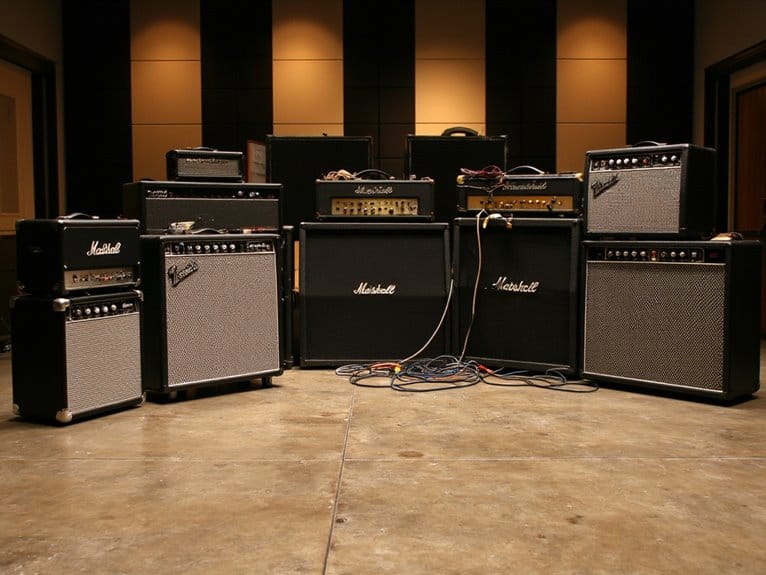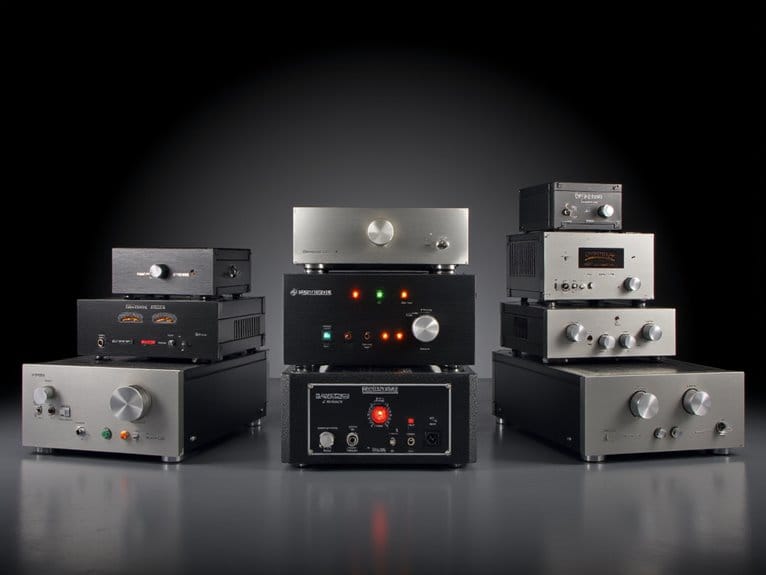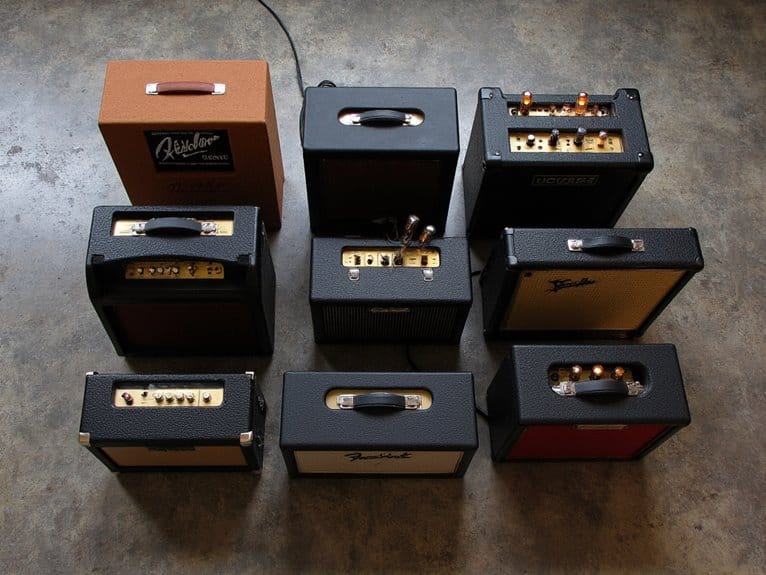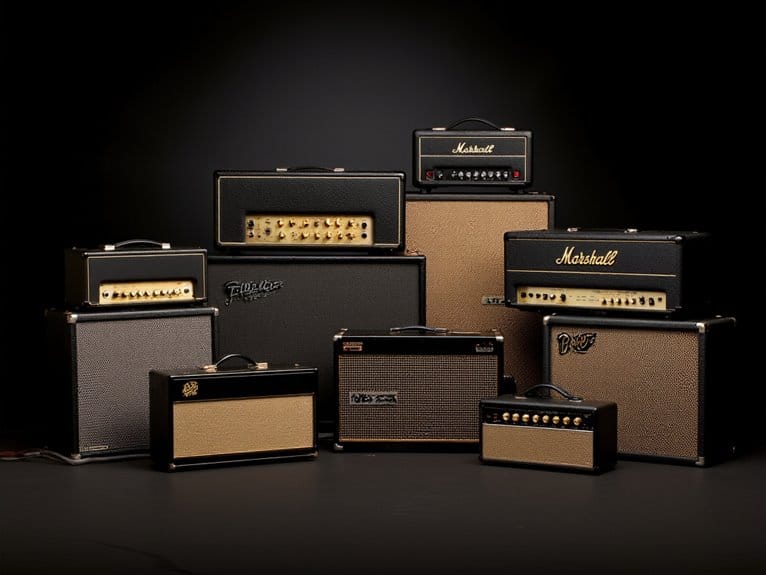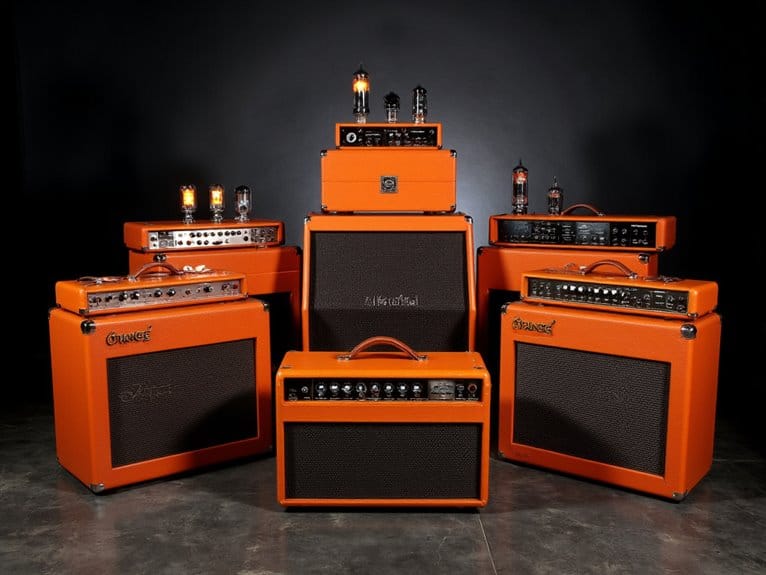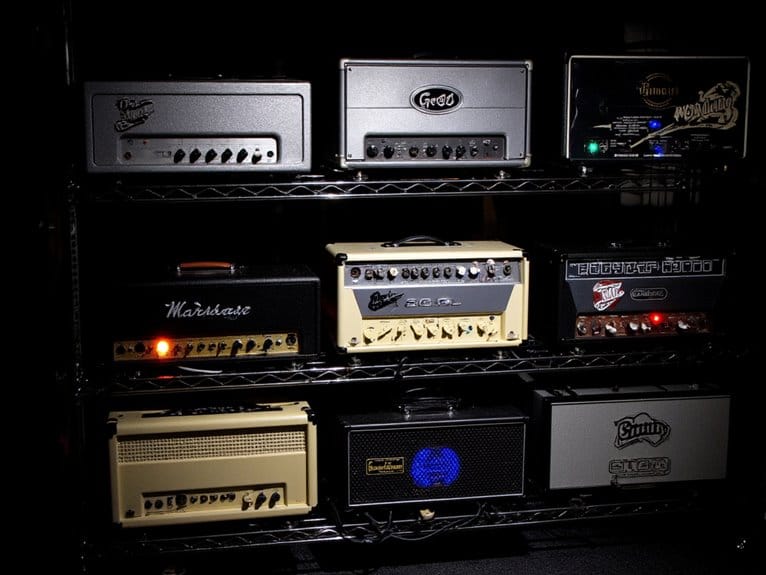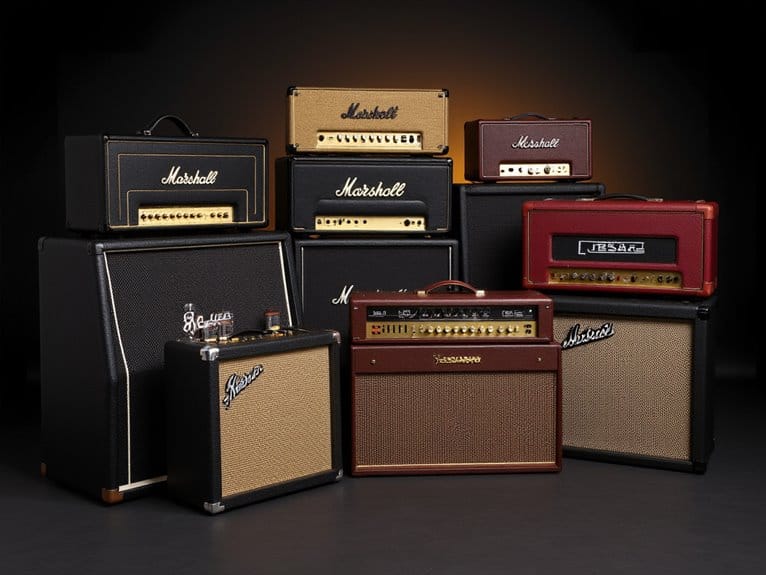Best Practice Bass Amps for Home and Studio Sessions
After testing dozens of practice bass amps, I’ve found the JOYO 10W Mini Bass Amp (MA-10B) and Fender Rumble 25 V3 consistently deliver the best value for home sessions, offering dual channels, 3-hour battery operation, and quality headphone outputs under three pounds. The ultra-portable Bass Headphone Amp Mini (JA-03) at just 1.41 ounces excels for silent practice, while the Vangoa 15W provides superior tonal flexibility with 4-band EQ controls—and there’s much more to examine when choosing your ideal setup.
We are supported by our audience. When you purchase through links on our site, we may earn an affiliate commission, at no extra cost for you. Learn more.
Notable Insights
- Practice bass amps range from 10W to 25W with compact designs weighing under 3 pounds for home use.
- Battery-powered models like JOYO MA-10B offer 3-4 hours of unplugged practice sessions for portability and convenience.
- Essential features include headphone outputs for silent practice and auxiliary inputs for playing along with backing tracks.
- 4-band EQ controls and dedicated drive channels provide tonal flexibility for sound customization and experimentation.
- Entry-level practice amps start around $50, with premium models exceeding $300, averaging 4.0-star customer satisfaction ratings.
JOYO 10W Mini Bass Amp Guitar Practice Amplifier (MA-10B)
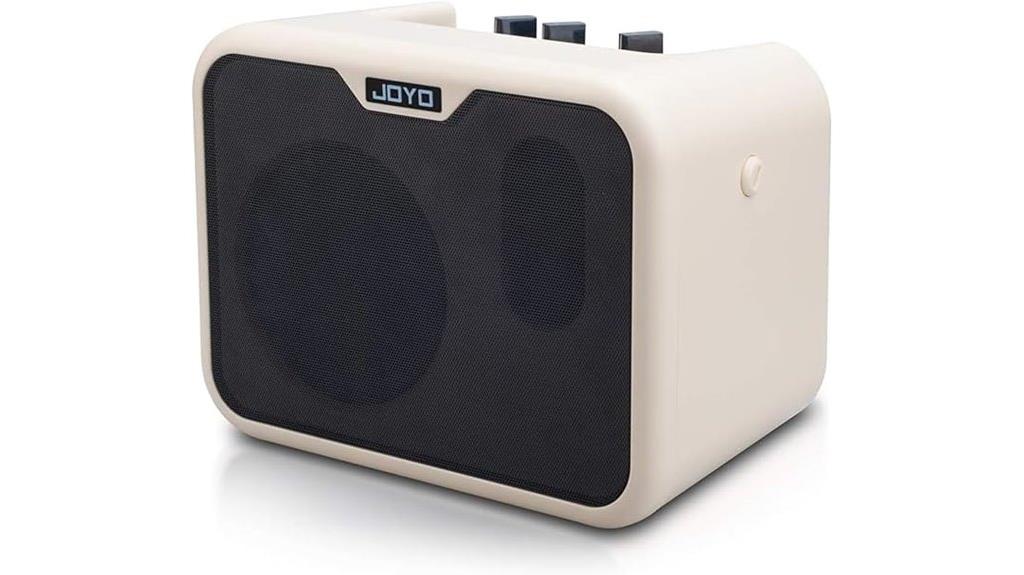
If you’re a beginning bassist seeking an ultra-portable practice solution, or an experienced player who needs silent rehearsal capabilities, the JOYO 10W Mini Bass Amp (MA-10B) delivers impressive functionality in a remarkably compact package. Weighing under three pounds, this battery-powered amplifier fits comfortably in most backpacks, providing up to three hours of outdoor jamming time when you can’t access wall power. You’ll appreciate the dual-channel design featuring both normal and drive modes, with the latter offering gain control for achieving those grittier, distorted tones that add character to your practice sessions. The built-in headphone jack guarantees silent rehearsals won’t disturb roommates or neighbors, while the auxiliary input lets you play along with backing tracks from your smartphone. Additionally, the JOYO 10W Mini Bass Amp is compatible with highly rated bass preamp pedals, allowing you to further refine your sound and enhance your performance. Whether you’re at home or on the go, this amp ensures that you have all the tools you need to experiment with various tones and effects. Its robust build and thoughtful design mean you can rely on it for both practice and small gigs without sacrificing quality.
Best For: Beginning bassists and experienced players who need an ultra-portable practice amplifier with silent rehearsal capabilities for home, outdoor, or travel use.
Pros:
- Ultra-portable design weighing under 3 pounds with battery power providing up to 3 hours of playtime
- Dual-channel functionality with normal and drive modes, plus gain control for distorted tones
- Silent practice features including headphone jack and AUX input for playing along with backing tracks
Cons:
- Limited 10-watt power output may not be sufficient for jamming with other musicians or small performances
- Battery life of only 3 hours requires frequent recharging or battery replacement for extended use
- Compact size likely limits speaker quality and bass response compared to larger practice amplifiers
Bass Headphone Amp Mini Guitar Practice Amplifier (JA-03)
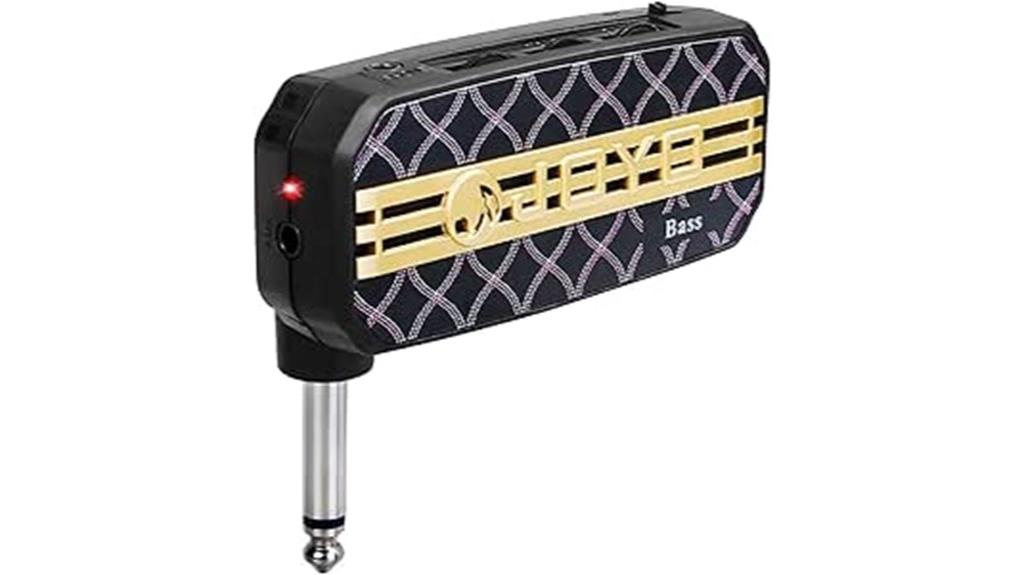
Weighing just 1.41 ounces and measuring a compact 3 x 3.15 x 1 inches, the JA-03 Bass Headphone Amp transforms any corner of your home into a silent practice studio, making it particularly valuable for apartment dwellers, late-night musicians, and anyone who needs to keep their bass practice sessions under wraps. You’ll find the plug-and-play functionality pleasantly straightforward, though I’ve noticed some users struggle with the 6.35mm jack’s connectivity reliability—a minor frustration that doesn’t overshadow its core purpose. The aux input cleverly allows you to jam along with backing tracks, while the tone knobs provide enough sonic flexibility for meaningful practice sessions, despite occasional background noise when you’re not actively playing.
Best For: Apartment dwellers, late-night musicians, and beginners who need a portable, affordable solution for silent bass and guitar practice sessions.
Pros:
- Ultra-portable design at just 1.41 ounces with plug-and-play functionality for convenient practice anywhere
- Aux input allows jamming along with backing tracks and music apps for enhanced practice sessions
- Clean, powerful sound with multiple tone options at a competitively affordable price point
Cons:
- Connectivity issues with the 6.35mm headphone jack causing unreliable connections
- Background noise present when not actively playing the instrument
- Limited volume output and gain that some users find insufficient for their needs
Vangoa Bass Guitar Amplifier 15W Portable Electric Bass Combo Amp

Musicians seeking their first serious practice amplifier, or those needing a reliable backup for performances, will find the Vangoa Bass Guitar Amplifier 15W delivers surprisingly robust sound through its 6.5-inch speaker and airtight wooden cabinet design. You’ll appreciate the 4-band EQ controls—treble, middle, bass, and presence—which provide more tonal flexibility than most budget amps offer, honestly. The hard metal construction with rubber padding means you won’t worry about minor drops during transport, while the top carry handle makes moving between practice spaces straightforward. Both 1/4-inch instrument and 1/8-inch auxiliary inputs accommodate different playing scenarios, from solo practice to jamming with backing tracks, making this amp surprisingly versatile for its price point.
Best For: Musicians seeking an affordable, portable practice amp or reliable backup amplifier that offers solid sound quality and versatile connectivity options for home practice, jamming sessions, and small performances.
Pros:
- 4-band EQ controls (treble, middle, bass, presence) provide excellent tonal flexibility for a budget amplifier
- Durable hard metal construction with rubber padding and convenient carry handle makes it ideal for transport
- Multiple input options (1/4-inch instrument and 1/8-inch auxiliary) allow for versatile playing scenarios including backing tracks
Cons:
- 15W power output may be insufficient for larger venues or outdoor performances without PA support
- 6.5-inch speaker size limits low-end frequency response compared to larger bass amplifiers
- Budget price point may indicate potential compromises in long-term reliability compared to premium amplifiers
Fender Rumble 25 V3 Bass Amplifier (25 Watts, 8 Inch Speaker)
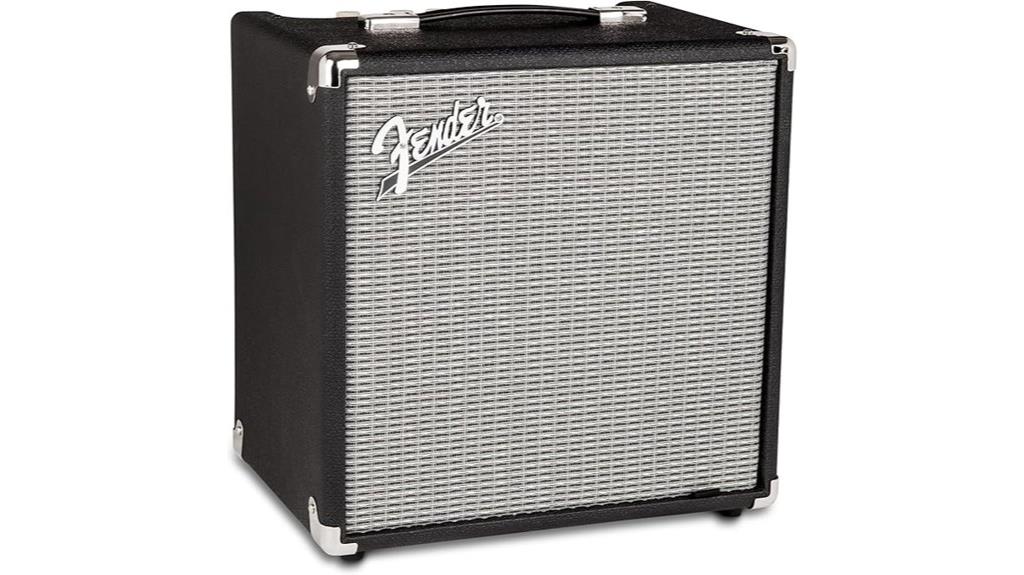
Compact practice sessions become markedly more versatile with the Fender Rumble 25 V3 Bass Amplifier, a 25-watt combo that I’ve found strikes an impressive balance between portability and tonal flexibility for bedroom warriors and apartment dwellers. You’ll appreciate the newly-developed overdrive circuit, which delivers surprisingly diverse bass tones from this modest 8-inch speaker configuration. The switchable contour controls let you dial in everything from classic gritty growl to modern punch, though I’ll admit the modern setting occasionally feels a bit ambitious for a practice amp. The ported enclosure genuinely enhances volume output and bass response beyond what you’d expect from this compact footprint.
Best For: Bass players who need a compact practice amp for home use, apartment dwellers, and beginners looking for versatile tonal options in a portable package.
Pros:
- Newly-developed overdrive circuit provides surprisingly diverse bass tones from a compact 8-inch speaker
- Switchable contour controls offer flexibility from classic gritty growl to modern punch sounds
- Ported speaker enclosure delivers enhanced volume and deeper bass response beyond expectations for its size
Cons:
- Modern contour setting can feel overly ambitious for a practice amp’s capabilities
- 25-watt power output limits use to practice scenarios rather than performance situations
- 8-inch speaker size inherently restricts the depth of bass frequencies compared to larger configurations
Ueteto 10W Mini Bass Amp, Portable Rechargeable Bass Guitar Practice Amplifier
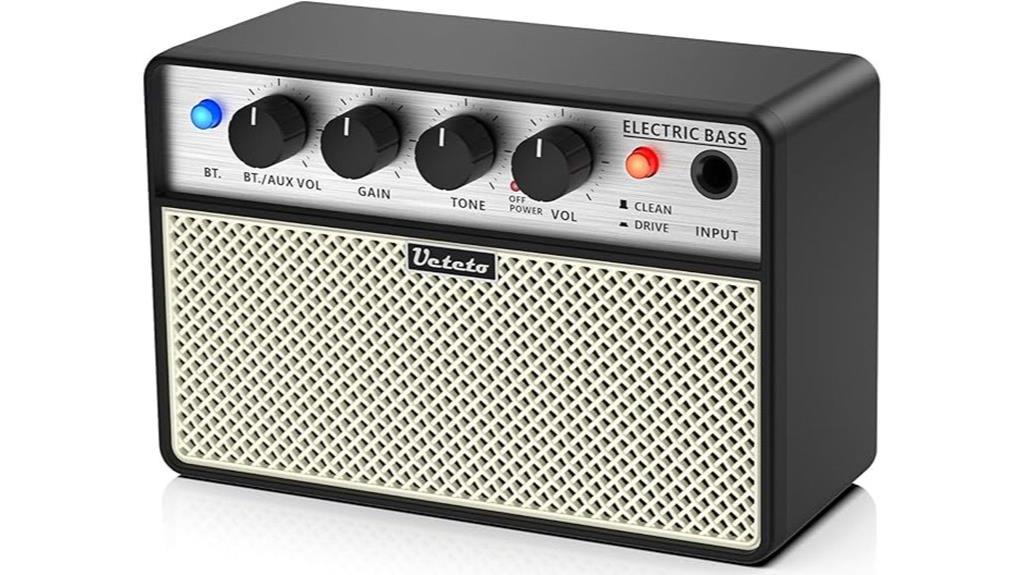
Bassists who practice in apartments, dorm rooms, or shared spaces will find their solution in the Ueteto 10W Mini Bass Amp, which delivers surprisingly robust low-end through its dual 5-watt subwoofers while maintaining a footprint that won’t dominate your practice area. You’ll appreciate the four-hour rechargeable battery that removes the need for constant wall outlet access, making this amp genuinely portable for backyard sessions or basement rehearsals. The two-channel design offers both clean and drive settings, while independent Bluetooth and AUX volume controls let you jam along with backing tracks without constantly adjusting your bass levels, and the headphone output guarantees you can practice without disturbing roommates or neighbors.
Best For: Bassists who need a compact, portable practice amp for apartments, dorm rooms, or shared living spaces where noise control and space efficiency are essential.
Pros:
- Dual 5-watt subwoofers deliver surprisingly powerful bass output despite the compact size
- 4-hour rechargeable battery provides true portability without requiring wall outlet access
- Independent volume controls for Bluetooth and AUX inputs plus headphone output offer flexible practice options
Cons:
- 10W total power may be insufficient for band rehearsals or small venue performances
- Limited to practice applications rather than professional or performance use
- No mention of effects or advanced tone-shaping features beyond basic clean/drive channels
Orange Crush Bass 25W Bass Guitar Combo Amp, Orange
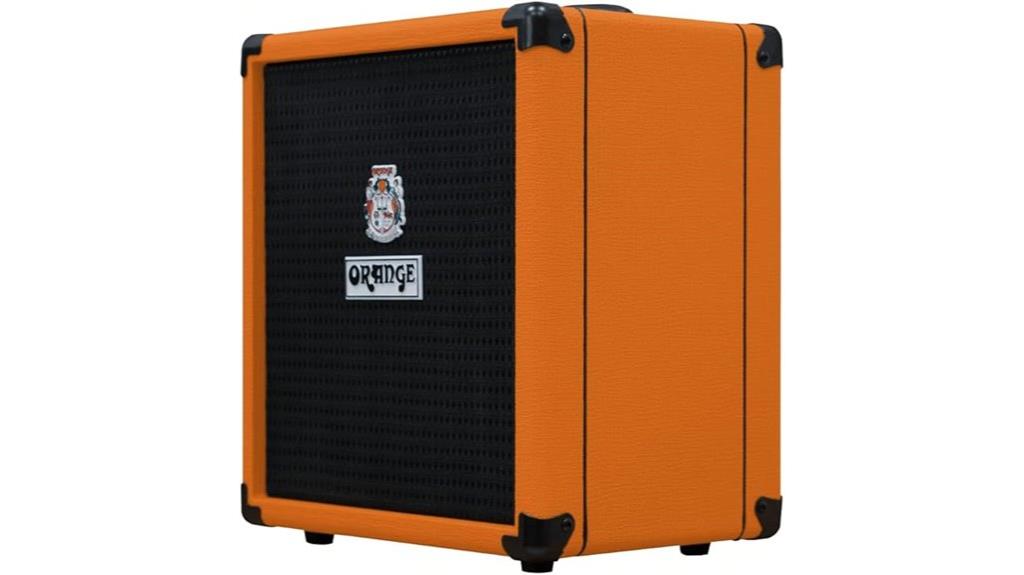
Orange’s reputation for delivering warm, vintage-inspired tones extends seamlessly into their bass amplifier lineup, with the Crush Bass 25W representing an ideal entry point for bedroom warriors and apartment dwellers who need genuine Orange sound without the neighbor complaints. You’ll find the active 3-band EQ with parametric mid control provides surprising tonal flexibility for a practice amp, while the built-in chromatic tuner eliminates the need for separate gear. The cabinet simulation on the headphone output actually sounds decent for silent practice sessions, and the analog signal path delivers that characteristic warmth that made legends like Geddy Lee choose Orange.
Best For: Beginner to intermediate bass players who need a compact, high-quality practice amp for home use, rehearsals, and light studio work with authentic Orange tone.
Pros:
- Active 3-band EQ with parametric mid control and built-in chromatic tuner provide excellent tonal flexibility and convenience for practice sessions
- Analog signal path delivers the warm, vintage Orange sound favored by legendary bass players like Geddy Lee and John McVie
- Compact and portable design (20.2 lbs) with headphone output featuring cabinet simulation for silent practice without disturbing others
Cons:
- 25W output is insufficient for live performances or band rehearsals with drums, limiting use to practice scenarios
- Lacks advanced features like a latching footswitch for the blend function that some users desire
- May leave players wanting more power as their skills and performance needs grow beyond home practice
Factors to Consider When Choosing a Practice Amp Bass
When I’m helping bassists select their ideal practice amplifier, I’ve learned that five vital factors consistently determine whether you’ll love or regret your purchase, each directly impacting your daily practice experience and long-term satisfaction. The power output, typically ranging from 10 to 50 watts for home practice, must balance adequate volume for your playing style with neighbor-friendly sound levels, while portability becomes essential if you plan to move between rooms, jam sessions, or travel with your gear. I always emphasize that sound quality features like EQ controls, built-in effects, and headphone outputs, combined with connectivity options such as auxiliary inputs and USB interfaces, plus the choice between battery-powered convenience and reliable AC power, will ultimately shape how effectively your practice amp supports your musical development.
Power and Wattage Requirements
Finding the right wattage for your practice bass amp requires balancing volume needs with practicality, and I’ve learned that most home players don’t need nearly as much power as they think they do. A 10-watt amp delivers plenty of volume for bedroom practice without angering neighbors, while 25 watts provides extra headroom for jamming with friends or achieving cleaner tones at moderate volumes. I’ve noticed that lower wattage amps tend to distort when pushed hard, whereas higher wattage options maintain clarity across different volume levels. Speaker efficiency matters greatly here, as larger drivers can produce richer bass tones even with modest wattage. If you’re planning silent practice sessions, prioritize amps with dedicated headphone outputs over raw power.
Portability and Weight Considerations
Although bass amps have traditionally been bulky beasts that require serious muscle to move, modern practice amps have revolutionized portability with designs that weigh as little as 2.5 pounds and slip easily into a backpack alongside your gear. I’ve found that compact dimensions around 5.91 x 9.45 x 6.69 inches make these amps incredibly travel-friendly, fitting into tight spaces without compromising performance. Battery operation adds another layer of convenience, delivering 3-4 hours of unplugged practice sessions for outdoor jamming or situations where outlets aren’t available. When evaluating portable options, I always check for built-in handles or backpack compatibility, as these transport features greatly impact your overall experience during extended practice sessions and frequent moves between locations.
Sound Quality Features
Beyond portability considerations, sound quality remains the cornerstone of any worthwhile practice amp, and I’ve learned that even budget-friendly models can deliver surprisingly rich tones when equipped with proper EQ controls and tone-shaping features. I prioritize amps with thorough tone controls, including bass, mid, and treble adjustments, which allow me to dial in everything from punchy, bright slap tones to warm, darker fingerstyle sounds. A dedicated drive channel proves invaluable for exploring distorted territory, while a quality headphone output guarantees I can practice silently without sacrificing the amp’s natural character. Built-in speakers should maintain clarity across all volume levels, and auxiliary inputs for playing along with tracks greatly enhance practice sessions.
Connectivity and Input Options
When selecting a practice bass amp, I’ve discovered that connectivity options can make or break your practice routine, transforming a simple amplifier into a versatile practice hub that accommodates everything from silent midnight sessions to full-band rehearsals. I always prioritize amps with headphone outputs alongside AUX inputs, which let me practice silently while jamming to backing tracks from my phone or MP3 player. Multiple input configurations are essential – I look for both 1/4″ instrument jacks and 1/8″ auxiliary connections to handle various devices seamlessly. Dual power options, including battery and AC operation, enhance portability considerably. Switchable channels between clean and drive tones provide versatility, while built-in mixers and tone controls offer precise sound adjustments during practice sessions.
Battery Vs AC Power
Power source selection directly impacts where and how you’ll use your practice bass amp, with each option presenting distinct advantages that align with different practice scenarios and musical lifestyles. I’ve found battery-powered amps excel in portability, letting me practice anywhere without hunting for outlets, though they’re typically limited to two-to-four-hour sessions depending on power configuration and usage patterns. AC-powered models deliver consistent performance with higher wattage outputs, making them superior for extended practice sessions in stable environments where reliability matters most. Dual-power amps offer the best flexibility, allowing me to switch between battery and AC based on location needs, while features like headphone outputs work effectively with either power source, providing silent practice versatility regardless of your chosen configuration.
Tone Control Capabilities
Nothing shapes your practice experience quite like having proper tone control capabilities, which transform a basic amp from a simple volume box into a versatile sound-shaping tool that adapts to your musical growth and stylistic preferences. I’ve found that independent EQ knobs, particularly bass, mid, and treble controls, allow you to dial in everything from punchy rock tones to smooth jazz sounds without switching gear. Drive channels with adjustable gain settings expand your sonic palette greatly, letting you explore both clean articulation and saturated overdrive within the same session. These tone-shaping features prove invaluable whether you’re practicing at home or jamming with others, giving you the flexibility to match different musical contexts and experiment with various playing techniques.
Budget and Value Comparison
Finding the sweet spot between budget constraints and feature requirements has become increasingly challenging in today’s bass amp market, where entry-level models starting around $50 can deliver surprisingly solid performance while premium options exceeding $300 offer professional-grade capabilities that might exceed most practice needs. I’ve learned that focusing on essential features like headphone outputs, AUX inputs, and basic tone controls provides the best value proposition for most players. Customer ratings averaging 4.0 stars typically indicate satisfactory performance, though I’ve noticed that lightweight, compact designs often offer better long-term value due to their portability advantages. However, I’d recommend factoring in warranty coverage, as budget amplifiers frequently come with limited post-purchase support that could impact your investment’s longevity.
On a final note
After testing numerous practice amps, I’ve found that these models deliver reliable performance for home sessions. Whether you’re seeking the portability of JOYO’s compact designs or the fuller sound of Fender’s Rumble series, each amp serves specific practice needs. I’d recommend starting with a 15-25 watt model, as they provide enough headroom for apartment practice while maintaining clarity at lower volumes.

